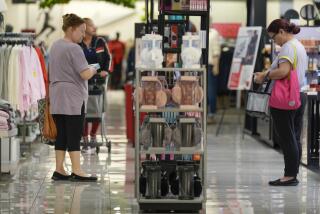Economic Growth in ’85 Put at 2.3% : Figure Is Much Lower Than Hoped For by Administration; Inflation Is 3.8%
WASHINGTON — The nation’s economic growth slowed to 2.3% during 1985, even lower than an earlier forecast and substantially below Reagan Administration hopes, the Commerce Department reported Wednesday.
Primarily because of a surge of imports late in the year, the Commerce Department also revised downward its growth estimate for the fourth quarter from an annual rate of 3.2% to 2.4%.
In a separate report, the Labor Department said inflation remained modest as consumer prices increased 3.8% for all of 1985, despite a 0.4% rise in December. It was the fourth consecutive year that inflation has been 4% or lower.
Figure Higher in L.A.
In the greater Los Angeles-Long Beach-Anaheim area, inflation was a substantially higher 4.8% during 1985. Local prices rose 0.3% in December, before seasonal adjustment.
Private economists generally agreed with the assessment of Commerce Secretary Malcolm Baldrige that “the staying power of this expansion depends heavily on our ability to keep inflation down and prospects are good that it will remain moderate.”
However, one analyst, Allen Sinai of Shearson Lehman Bros. in New York, said the Commerce Department report “points to an economy that is still growing, but is soft.” Sinai also warned that “the best news is behind us” on inflation, although he said a return to the soaring price increases of the late 1970s seems unlikely.
For all of 1985, the estimated increase in the gross national product, a measure of the nation’s total output of goods and services, was revised downward one-tenth of a percentage point from the 2.4% increase projected last month. The new estimate is well below the Administration’s initial prediction of 4% growth--pared back last summer to 3%--and falls far short of the 6.6% growth recorded in 1984.
Although the economy failed to achieve the Administration’s predicted 4% growth rate last year, Baldrige insisted that “prospects seem good” to reach it in 1986. Many private economists, however, foresee growth this year of little better than 2.5% to 3%.
Baldrige, in a briefing for reporters, also said he expects U.S. exports to pick up this year as the impact of the weaker dollar--now some 25% below its peak a year ago--is felt in world markets. But he conceded that imports are likely to continue at current high levels. “Foreign companies aren’t going to give up their market positions easily--they’re going to cut their prices first,” he said.
13% Surge in Imports
The trade deficit, fed by a steep 13% surge in imports, increased $7.8 billion in the fourth quarter to a record annual rate of $127.6 billion, the Commerce Department estimated. But several analysts noted that the estimate was based on data only for October--a month in which merchandise imports soared--and predicted that the trade picture would appear more favorable when revised estimates are issued in several months.
Michael Evans, who heads his own forecasting firm in Washington, complained: “They got it wrong again, and the reported decline in net exports for the whole quarter probably didn’t happen. We had a big increase in manufacturing and manufacturing employment in December. That had to go somewhere.”
As for inflation, the Labor Department attributed last month’s rise to a continuing year-end spurt in food and energy prices, an impact economists believe will be reversed as the current plunge in crude oil prices works its way to the retail level.
“When I look out there and see what oil prices are doing, I feel there has to be some decline in inflation,” said Robert F. Wescott of Wharton Econometrics, a Philadelphia consulting firm.
Impact of Falling Dollar
Sinai said his only concern is the impact of the falling dollar, which adds to the cost of imported goods. He worried, however, that the trade figures mean that “the weakness of the industrial sector remained a chronic problem in the fourth quarter.”
Irwin Kellner, chief economist at Manufacturers Hanover Trust in New York, agreed that the reported trade deficit had a depressing impact on fourth-quarter growth. But he found encouragement in other details of the report.
“Most economists would agree that we are at the point now where we can expect to see substantial improvement in the trade deficit because of the drop in the dollar,” Kellner said. “If you look at the rest of the numbers, you have to be encouraged because there were important pluses.”
Among those pluses, he said, were a 2.1% rise in real final sales to consumers and a $14.5-billion increase in business inventories, excluding farms. DECLINING GROWTH, LOWER INFLATION
Change in annual gross national product, adjusted for inflation; and changein the consumer price index from December to December)
Economic growth Inflation 1980 -0.2% 12.4% 1981 1.9 8.9 1982 -2.5 3.9 1983 3.4 3.8 1984 6.6 4.0 1985 2.3 3.8
Sources: Commerce Department, Labor Department
More to Read
Inside the business of entertainment
The Wide Shot brings you news, analysis and insights on everything from streaming wars to production — and what it all means for the future.
You may occasionally receive promotional content from the Los Angeles Times.










